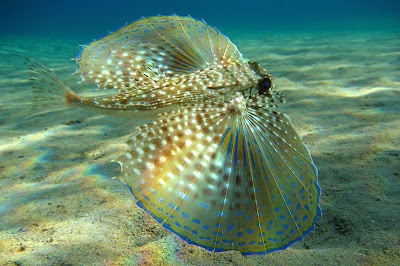The first time I saw these guys was while critter diving in the Philippines. It was fascinating to watch them spread their wings and "take flight". I never got tired seeing them. I may have only spotted them in the Philippines, but the flying gurnard can be found from Hawaii to Japan, southward to central Polynesia, westward through Micronesia and Melanesia, through the East Indies, and across the Indian Ocean to the coast of Africa. They prefer sandy bottoms and are generally found in shallow waters near the shore, but can be found at depths of up to 330 feet.
Flying Gurnards are classified in the scientific family Dactylopteridae, meaning "finger-fin". The word "gurnard" actually comes from an Old French word meaning "grunt". These fish get their name because of a special muscle in their bodies that pounds against their swim bladder when they are removed from the water, causing them to make a grunting sound. (Another common name for these fish is Sea Robin.)
These fish can actually grow up to 16 inches and are usually a grayish-brown color with dark markings and bright blue edges on their round pectoral fins. These pectoral fins are normally held tight to their bodies unless they feel threatened, then they expand their "wings" to increase their size and scare off predators. This also helps them to blend into their bottom surroundings.
As you know, flying gurnards don't actually fly. However, they can use their "wings" to help make short burst of "flight" through the water. To motor around, they generally use finger-like appendages on the front of their pelvic fins to walk on the ocean floor, hence their family classification. They search through the sand to munch on bony fish, crustaceans, and bi-valves.
 These fish have been described as resembling frogs when you look at them from the side because of their large heads and eyes, and light-colored underbellies. Their body is covered in "armor" consisting of tough, prickly scales and two large hook-like spurs near the gills. So here's my question, how can these tough guys look so cute?
These fish have been described as resembling frogs when you look at them from the side because of their large heads and eyes, and light-colored underbellies. Their body is covered in "armor" consisting of tough, prickly scales and two large hook-like spurs near the gills. So here's my question, how can these tough guys look so cute?



No comments:
Post a Comment